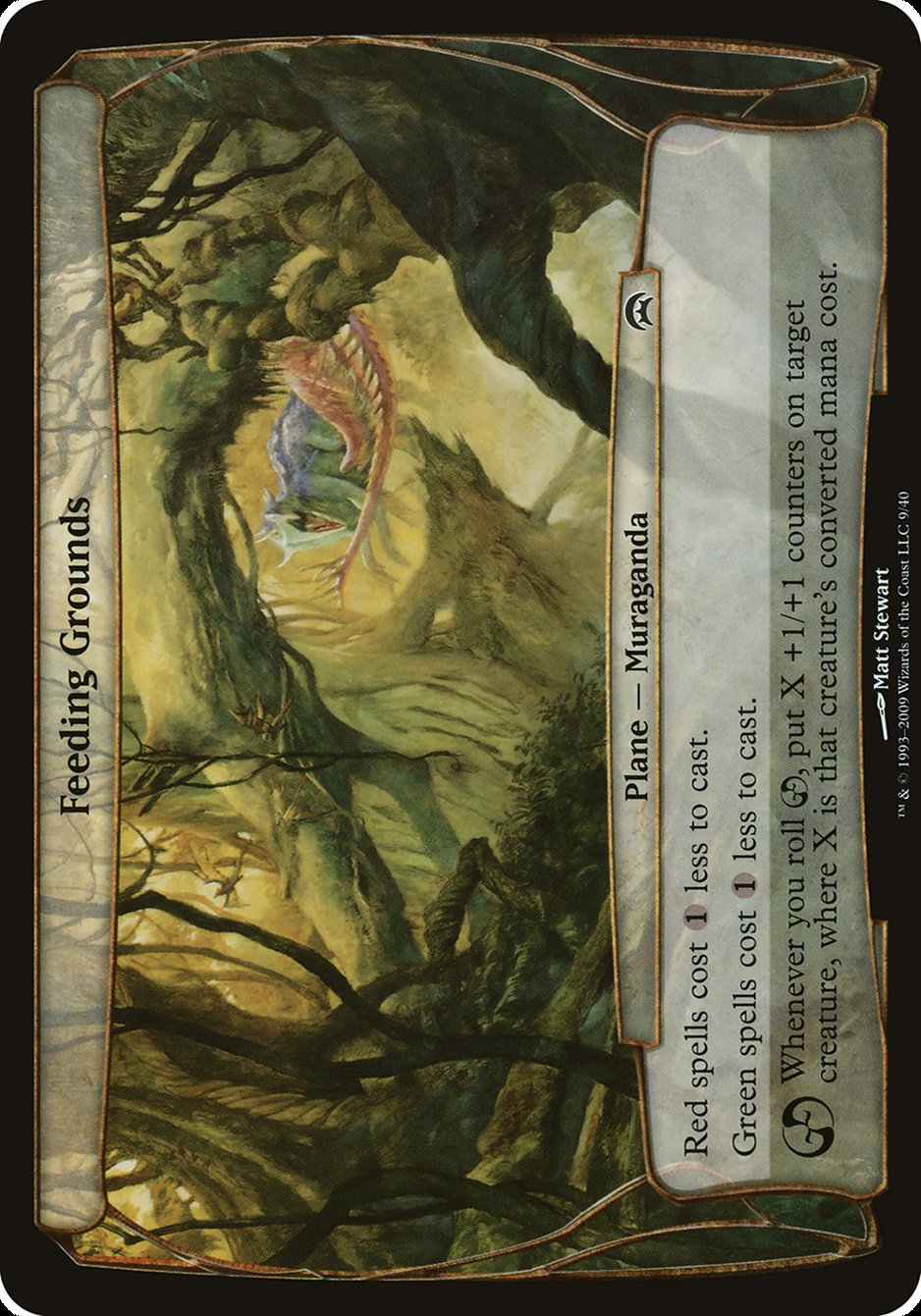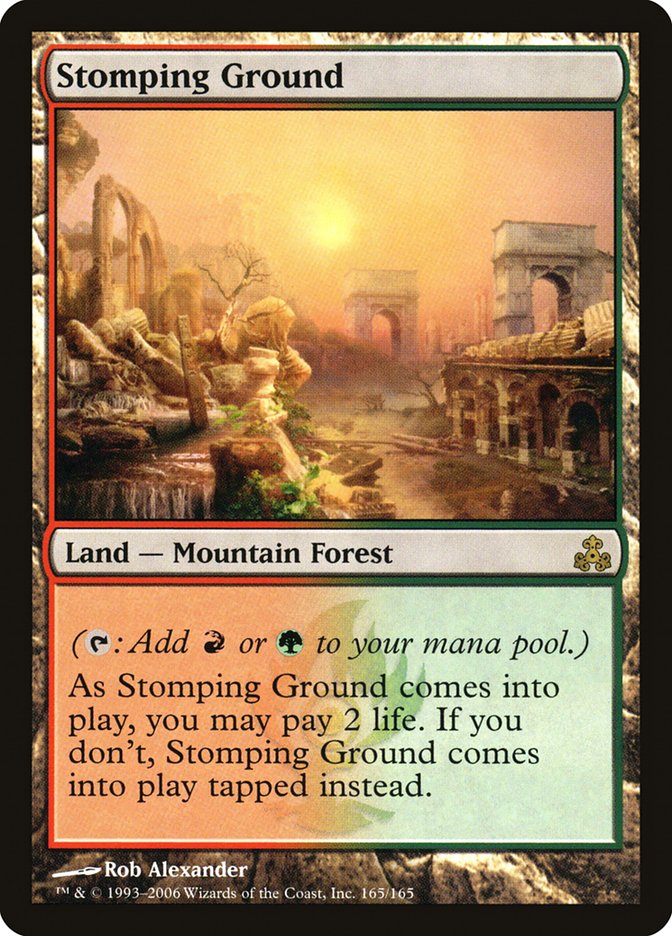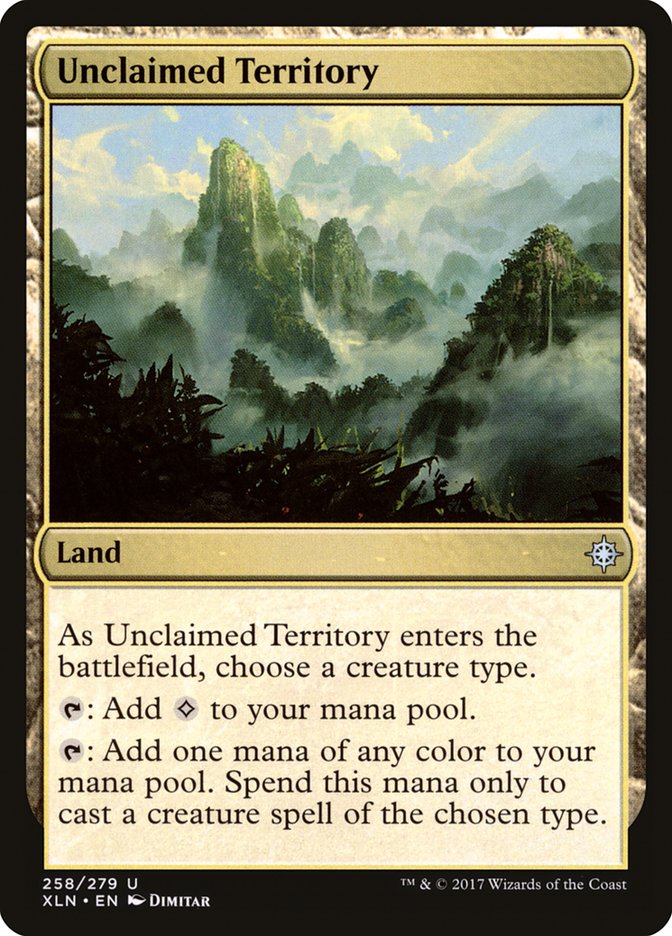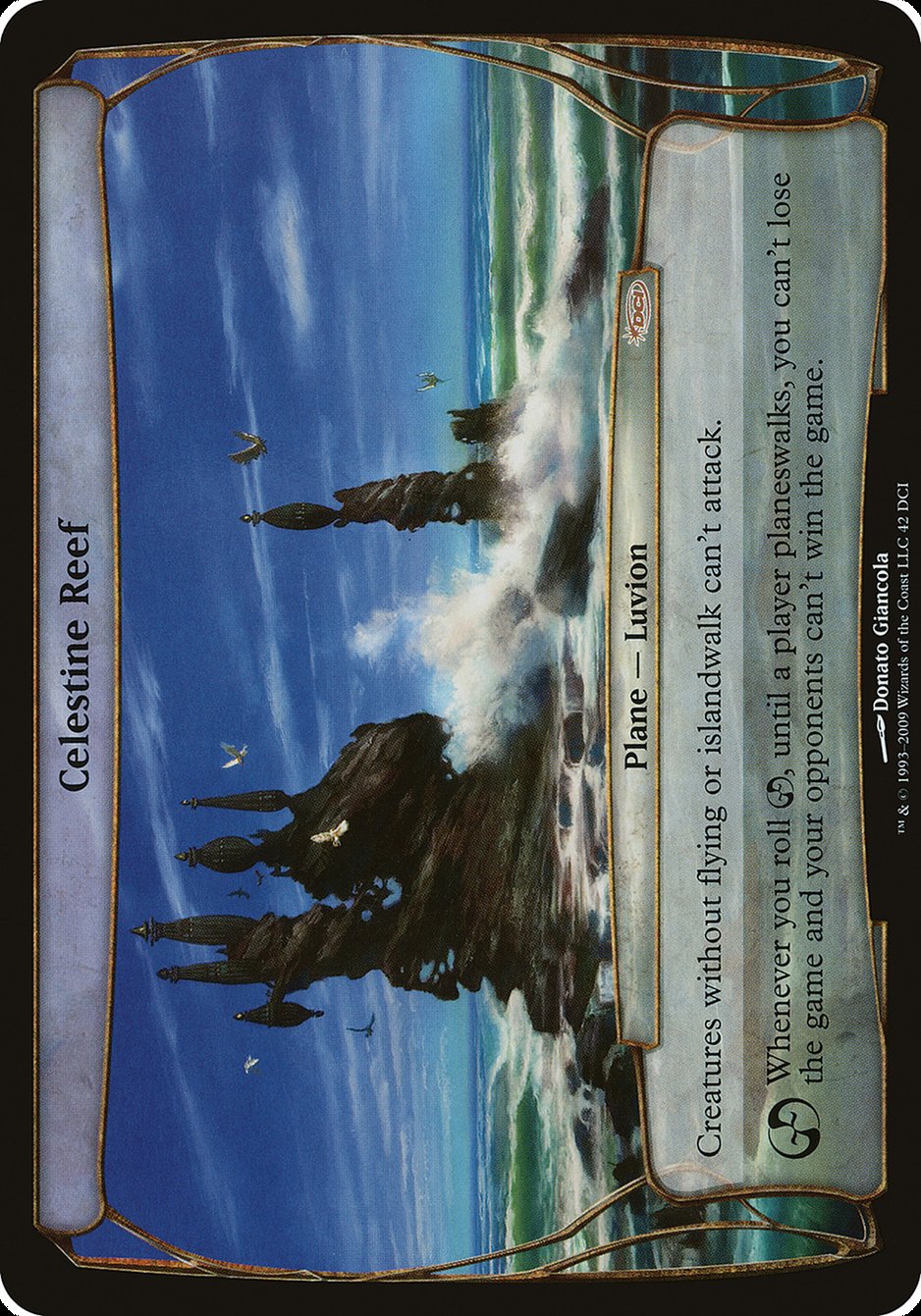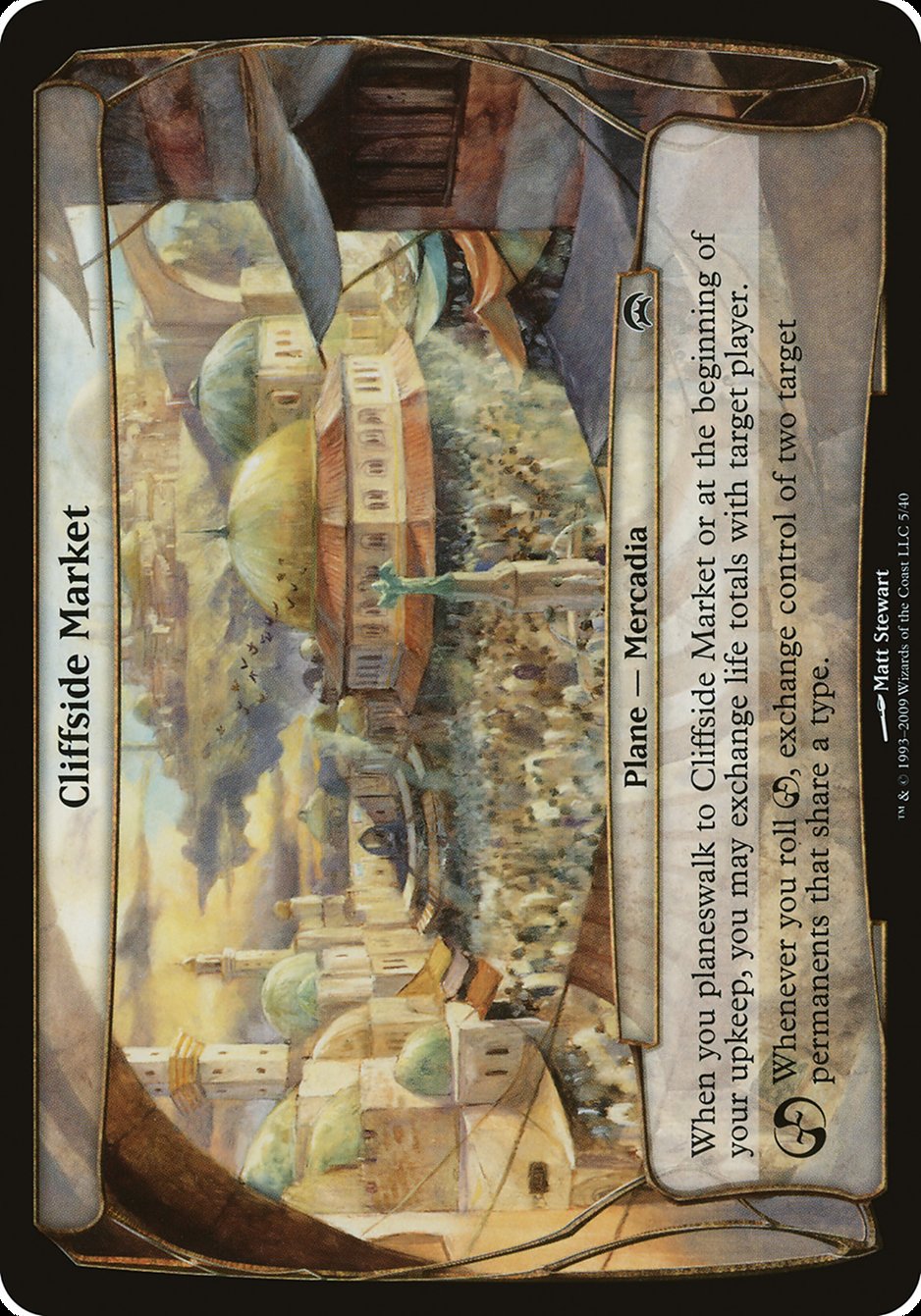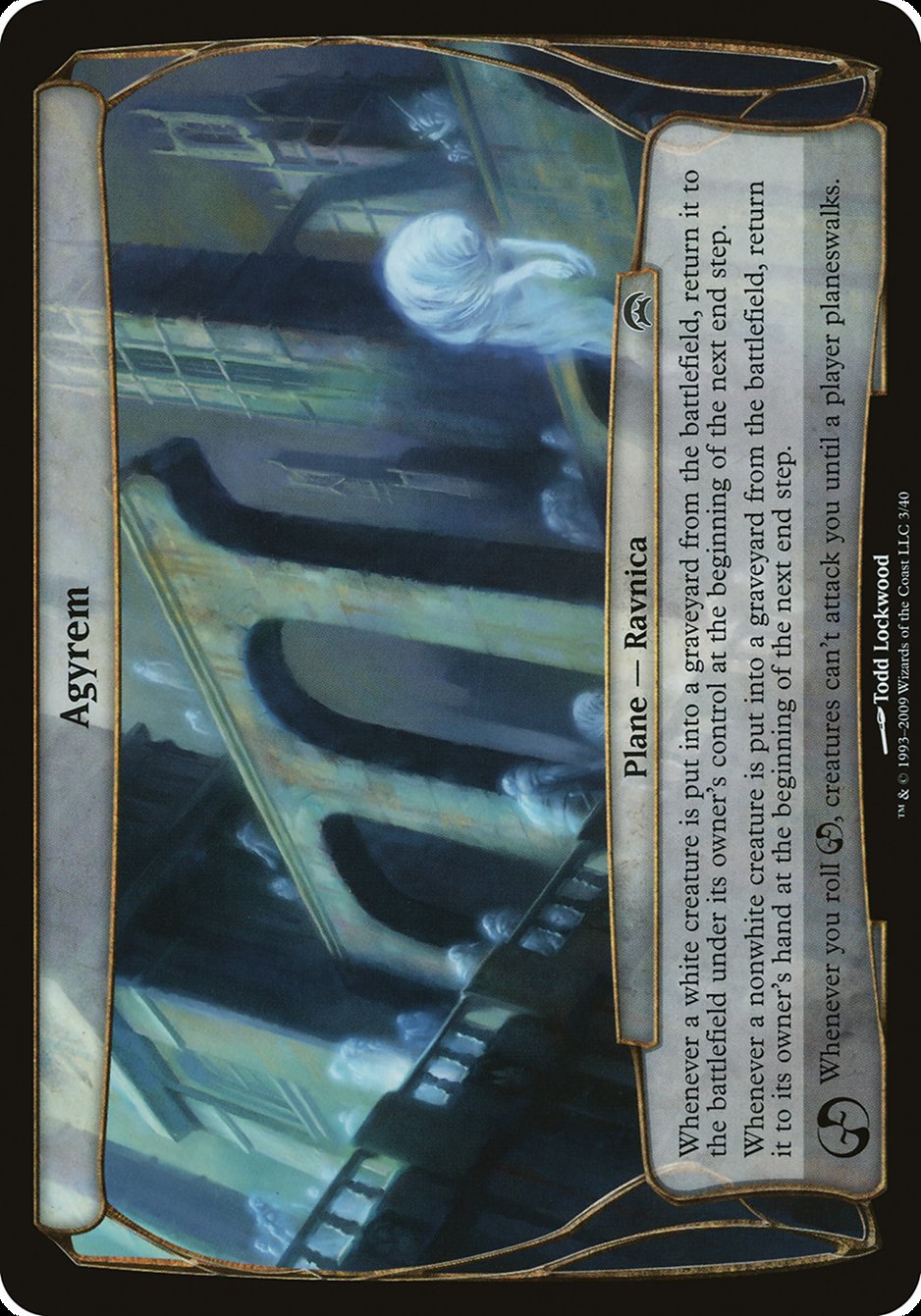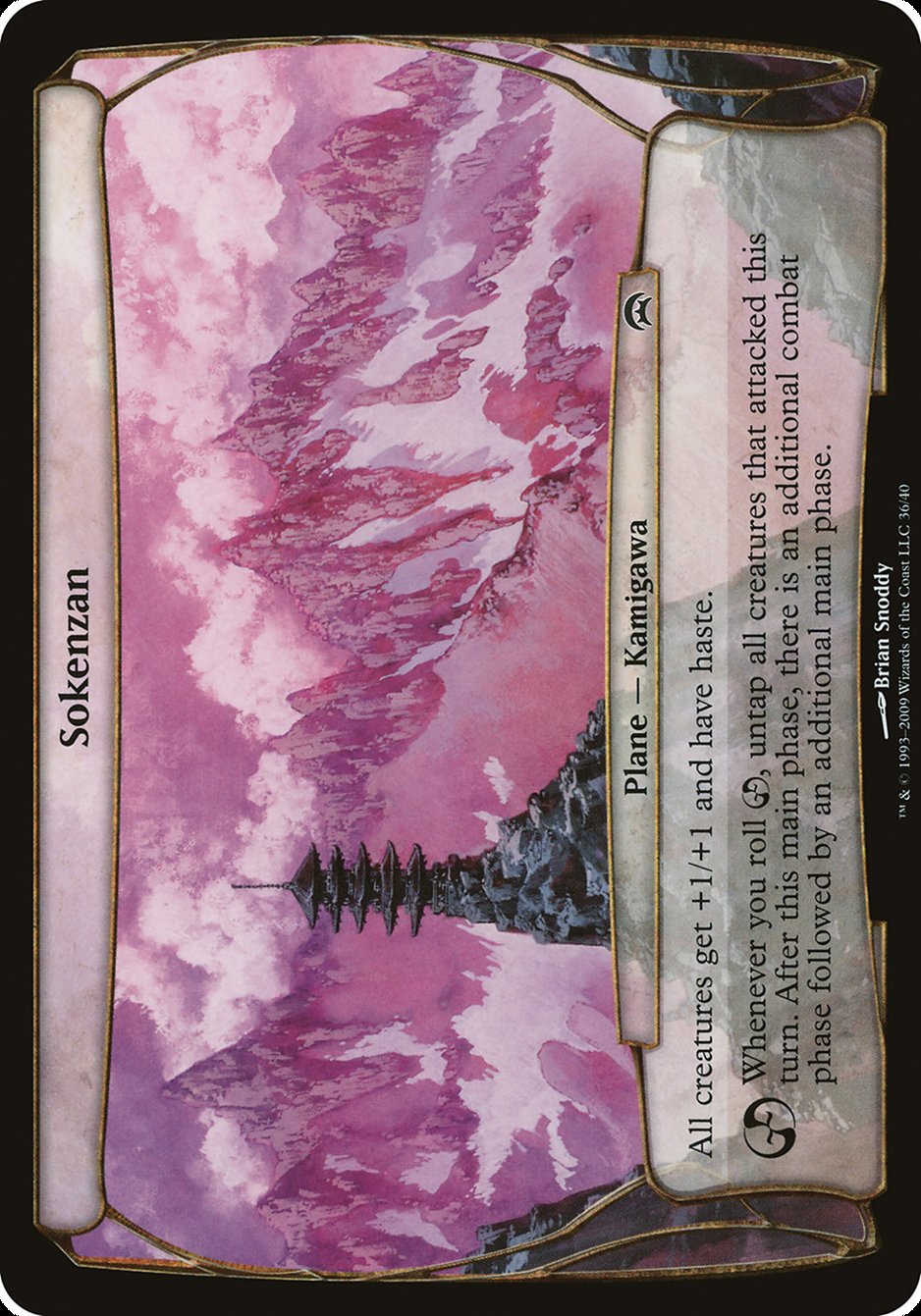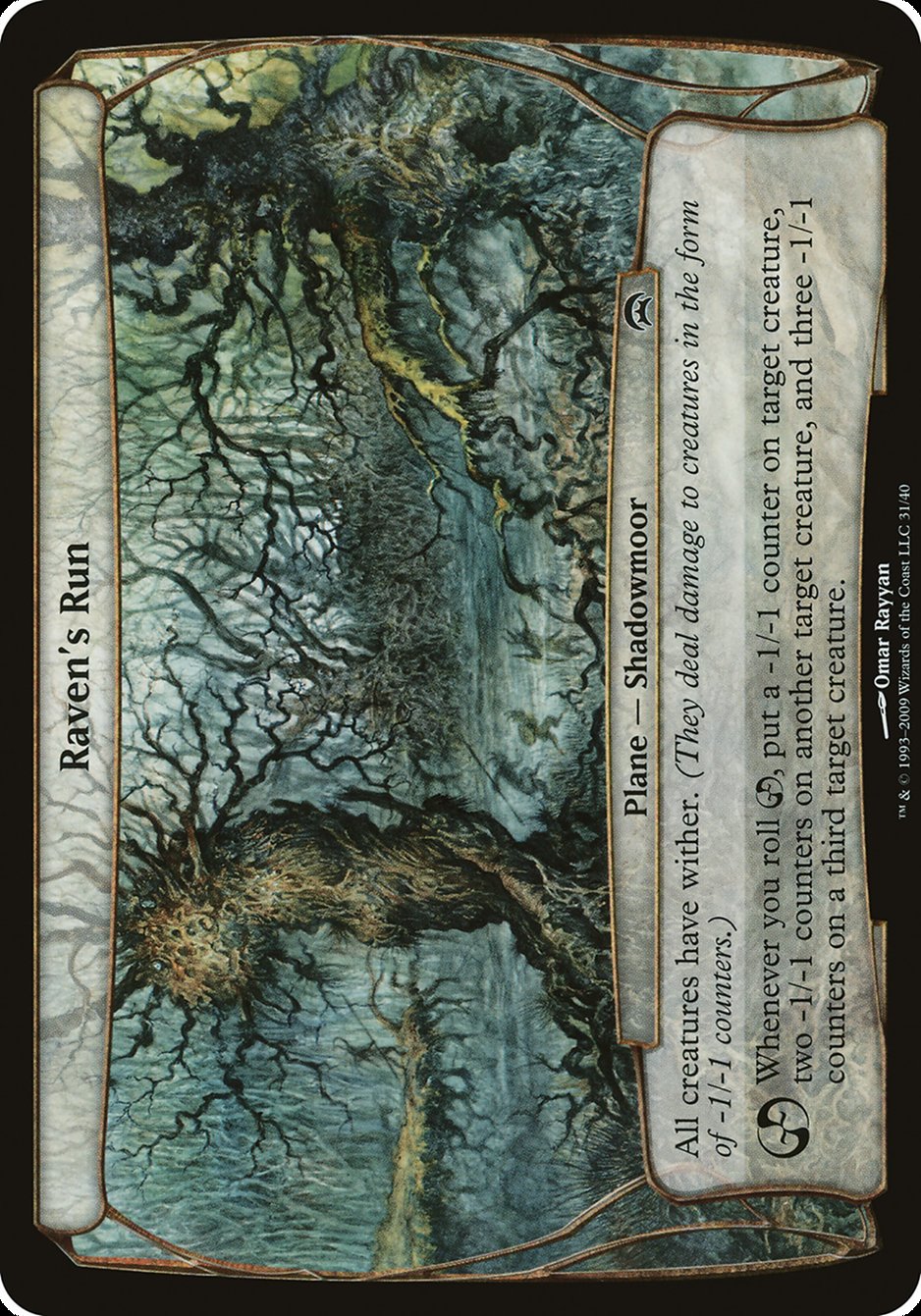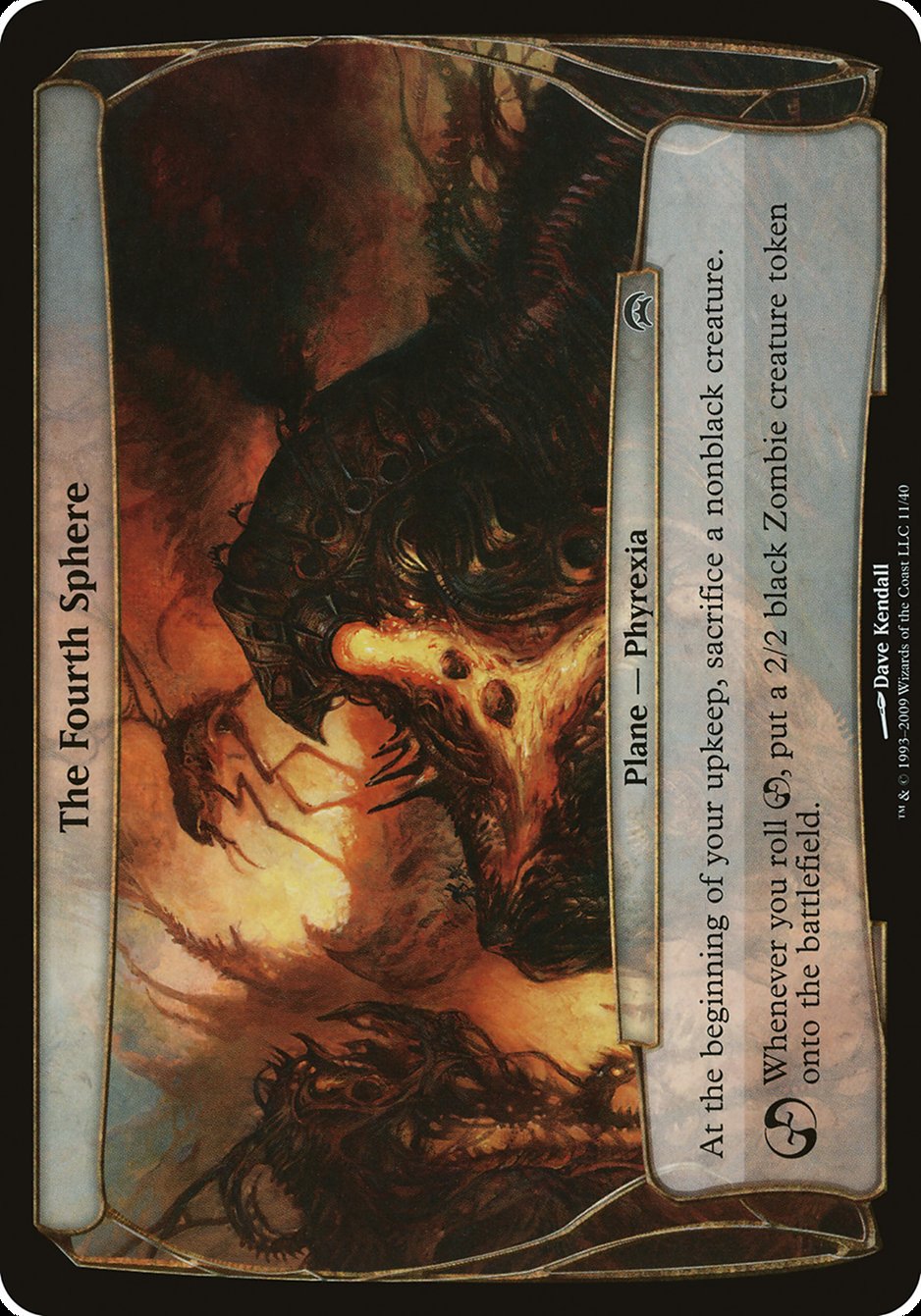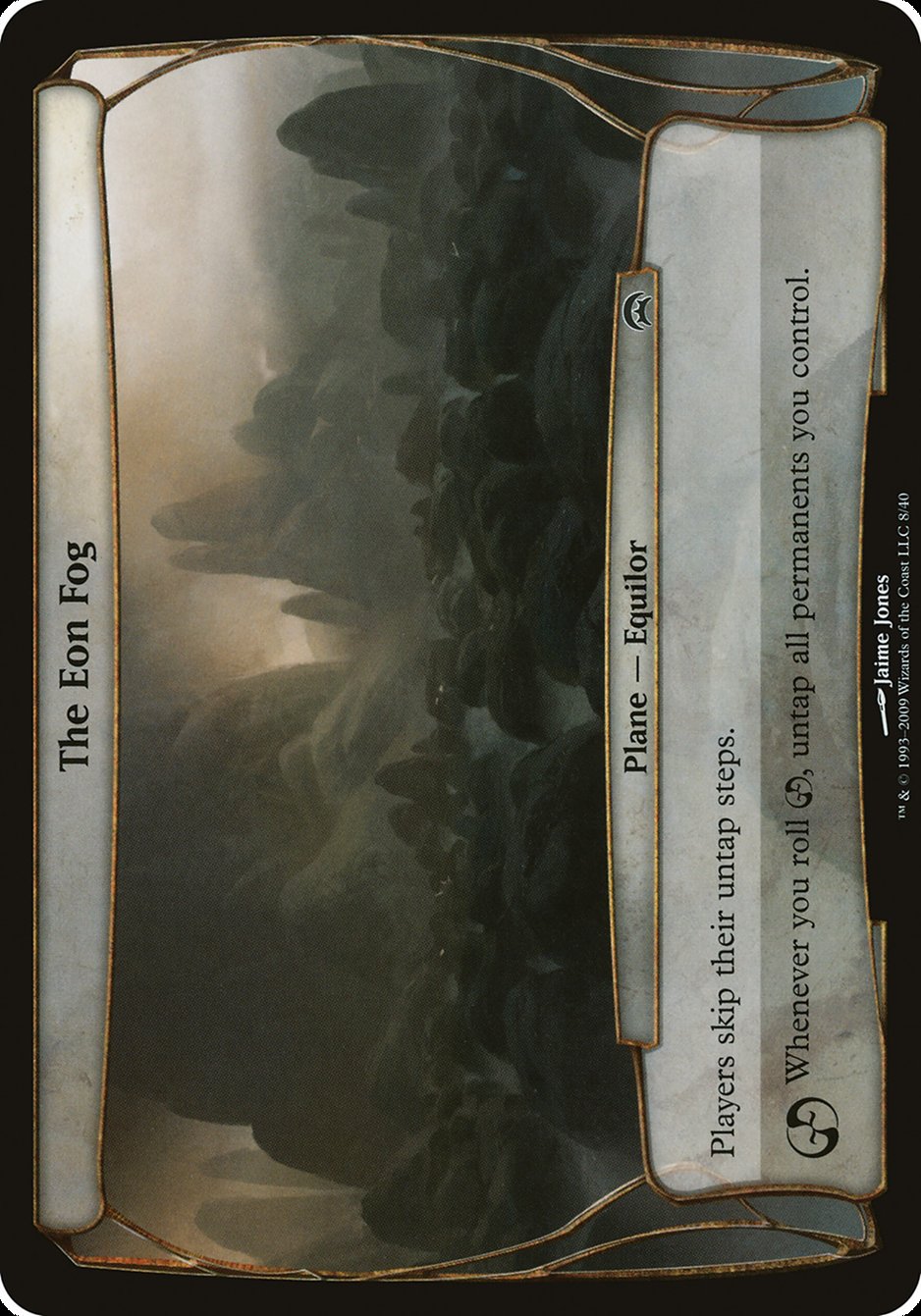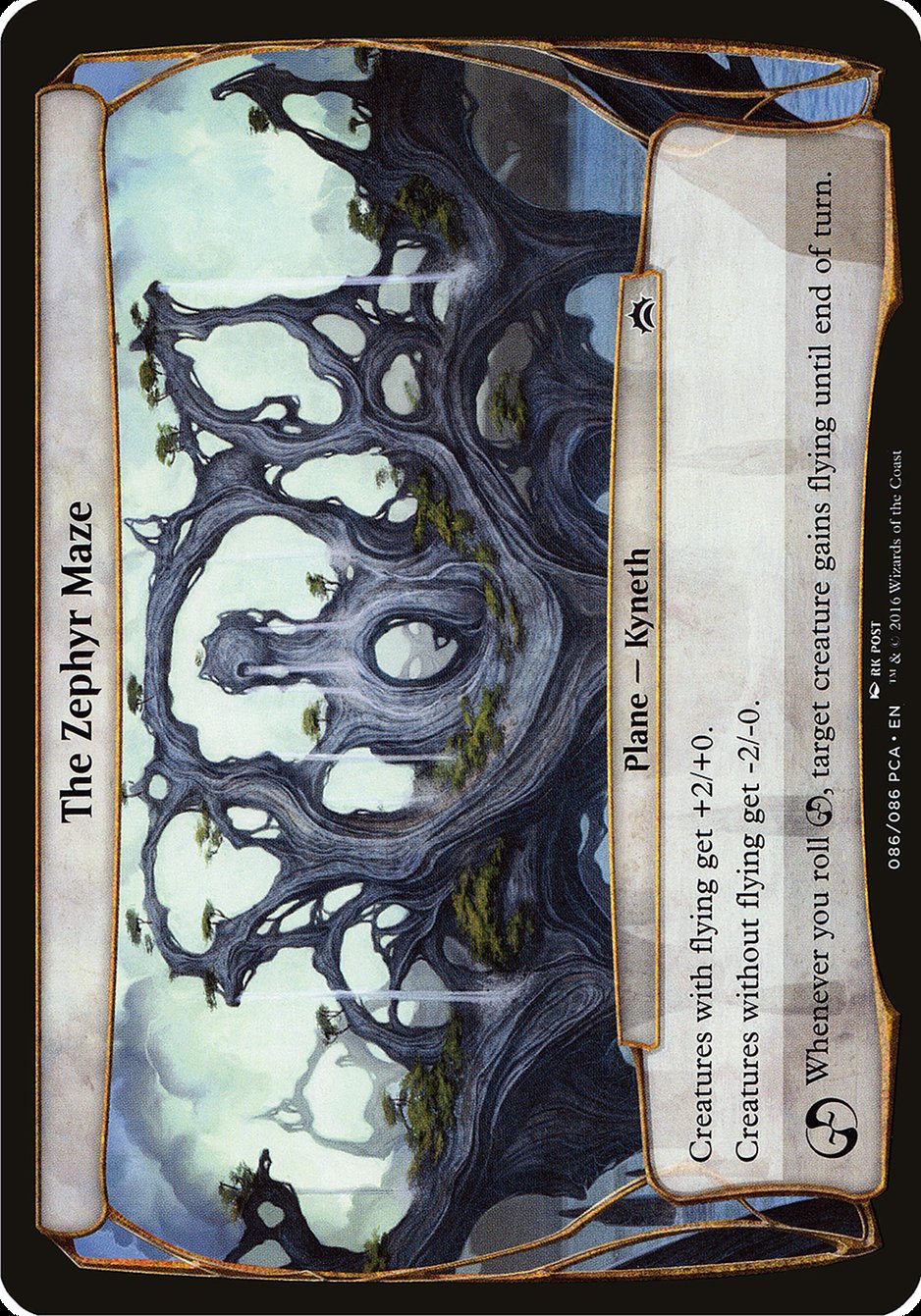Terrenos de Caza Carta MTG
| Colecciones da carta | Lanzado en 2 coleccionesVer todos |
| Rareza | Común |
| Tipo | Plano — Muraganda |
Texto de la carta
Cuesta {1} menos lanzar los hechizos rojos. Cuesta {1} menos lanzar los hechizos verdes. Siempre que lances caos, pon X contadores +1/+1 sobre la criatura objetivo, donde X es el coste de maná convertido de esa criatura.
Cartas Similares
Feeding Grounds, en el diverso mundo de Magic: The Gathering, ofrece una herramienta única para los constructores de mazos. Comparado con tierras como Rootbound Crag, Feeding Grounds comparte la característica de revisar por un tipo de tierra para entrar al campo de batalla sin estar girada. Sin embargo, donde difiere es en su habilidad para potenciar criaturas, bastante distinta a la provisión directa de mana de Rootbound Crag.
Dentro de esta esfera, también tenemos cartas como Stomping Grounds, que entra sin estar girada a cambio de dos vidas. Aunque no potencia criaturas, provee mana inmediato y flexible. Luego está Unclaimed Territory, que aunque no ofrece ningún impulso a las criaturas o no entra sin estar girada a menos que estés jugando un cierto tipo de criatura, puede ser increíblemente útil en mazos tribales para arreglar el mana.
Después de sopesar los beneficios de estas alternativas, Feeding Grounds puede ser muy ventajoso en mazos que aprovechan el poder de las criaturas, destacándose en un nicho que equilibra la utilidad de tierras con el potencial de mejorar la presencia en el tablero.
Cartas similares a Terrenos de Caza por color, tipo y coste de maná
Beneficios de la carta
Ventaja de cartas: Feeding Grounds es un activo valioso cuando buscas superar a tus oponentes con un flujo de cartas incrementado. Te brinda mayores posibilidades de sacar las respuestas correctas o las amenazas reforzando tu mano, haciendo que cada paso de robo sea potencialmente más impactante.
Aceleración de recursos: Esta carta potencia tu reserva de mana, suavizando tu curva y permitiéndote lanzar hechizos más costosos antes de lo habitual. La aceleración de recursos es crucial para obtener una ventaja y Feeding Grounds lo logra desbloqueando hechizos potencialmente antes de su curva natural.
Velocidad instantánea: La capacidad de operar a velocidad instantánea con Feeding Grounds te proporciona flexibilidad táctica. Te permite adaptarte al estado evolutivo del juego, responder hábilmente a las acciones del oponente y realizar jugadas decisivas que podrían cambiar la marea a tu favor en los momentos más oportunos.
Desventajas de la carta
Requisito de descarte: Feeding Grounds requiere descartar otra carta de tu mano para activar su habilidad. Esto puede ser una desventaja significativa cuando tu tamaño de mano ya está comprometido o cuando la carta descartada podría haber sido crucial para jugadas futuras.
Costo específico de mana: La activación de Feeding Grounds está bloqueada detrás de una combinación específica de costos de mana. Esto puede restringir su integración en mazos multicolores que quizás no produzcan consistentemente los tipos correctos de mana sin la ayuda de una base de mana desarrollada o herramientas de fijación.
Costo de mana comparativamente alto: La inversión de mana para activar Feeding Grounds en línea podría resultar más pesada que beneficiosa, especialmente al compararla con otras opciones en el mismo rango de mana. Los jugadores a menudo evalúan el costo de oportunidad de tal carta, considerando si el efecto justifica el costo o si podría ralentizar su plan de juego general.
Razones para incluir en tu colección
Versatilidad: Feeding Grounds es una carta dinámica que podría integrarse sin problemas en varios arquetipos de mazos, incluidos aquellos que se enfocan en la aceleración de tierras o estrategias centradas en criaturas.
Potencial de combo: Esta carta puede potencialmente desencadenar jugadas explosivas al interactuar con efectos que se benefician de un mana aumentado o del fortalecimiento de las criaturas.
Relevancia para el meta: En un entorno donde los juegos se deciden por el tempo y la presencia en el campo, Feeding Grounds podría ofrecer esa ventaja crucial, permitiendo un desarrollo más rápido y abrumando a tus oponentes.
Cómo vencer
Feeding Grounds es una carta única que puede cambiar la dinámica de un juego al potenciar las criaturas dentro de un entorno específico. Para contrarrestar eficazmente esta carta, los jugadores deben enfocarse en estrategias de control que limiten o anulen la influencia de la carta. Desplegar hechizos de eliminación específicos que eliminen criaturas clave o usar limpiezas de campo para despejar el tablero puede obstaculizar la efectividad de la carta. La eliminación de encantamientos, como Disenchant o Naturalize, puede deshacerse directamente de Feeding Grounds, arrancando rápidamente la base que proporciona a la estrategia de tu oponente.
Otra táctica es utilizar contramagia para evitar que Feeding Grounds llegue al campo. Denegarle a tu oponente la oportunidad de establecer su configuración es crucial para mantener la ventaja. Alternativamente, transformar tu propia estrategia para capitalizar los beneficios de Feeding Grounds y al mismo tiempo interrumpir los planes de tu oponente puede ser un giro inteligente. Se trata de adaptabilidad y ejecución oportuna de tus hechizos para superar las ventajas que presenta Feeding Grounds.
Comprender las fortalezas de la carta y desarrollar un plan de juego que neutralice o aproveche esas fortalezas contra tu oponente es clave para la victoria. Ten en cuenta estas estrategias y estarás bien equipado para derrotar cualquier mazo que dependa del poder de Feeding Grounds.
Donde comprar
Si estás buscando comprar una carta MTG Terrenos de Caza de un coleccione específico como Planechase Planes and Planechase Anthology Planes, existen varias opciones confiables que debes considerar. Una de las fuentes principales es tu tienda de juegos local, donde a menudo puedes encontrar paquetes de refuerzo, cartas individuales y mazos preconstruidos de colecciones actuales y pasadas. A menudo ofrecen el beneficio adicional de una comunidad donde puedes intercambiar con otros jugadores.
Para un inventario más amplio, particularmente de colecciones más antiguos, mercados en línea como TCGPlayer, Card Kingdom y Card Market ofrecen amplias selecciones y te permiten buscar cartas de colecciones específicos. Las plataformas de comercio electrónico más grandes como eBay y Amazon también tienen listados de varios vendedores, lo que puede ser un buen lugar para buscar productos sellados y hallazgos raros.
Además, el sitio oficial de Magic suele tener un localizador de tiendas y listas de minoristas para encontrar Wizards of the Productos con licencia costera. Recuerde comprobar la autenticidad y el estado de las cartas al comprarlas, especialmente a vendedores individuales en mercados más grandes.
A continuación se muestra una lista de algunos sitios web de tiendas donde puede comprar las Terrenos de Caza y otras cartas MTG:
 COMPRAR
COMPRAR BurnMana es un socio oficial de TCGPlayer
- eBay
- Card Kingdom
- Card Market
- Star City Games
- CoolStuffInc
- MTG Mint Card
- Hareruya
- Troll and Toad
- ABU Games
- Card Hoarder Magic Online
- MTGO Traders Magic Online
Ver productos MTG
Impresiones
La carta Terrenos de Caza Magic the Gathering se lanzó en 2 colecciones diferentes entre 2009-09-04 y 2018-12-25. Ilustrado por Matt Stewart.
| # | Liberado | Nombre | Código | Símbolo | Número | Marco | Disposición | Borde | Artista |
|---|---|---|---|---|---|---|---|---|---|
| 1 | 2009-09-04 | Planechase Planes | OHOP | 9 | 2003 | Planar | Negra | Matt Stewart | |
| 2 | 2018-12-25 | Planechase Anthology Planes | OPCA | 23 | 2015 | Planar | Negra | Matt Stewart |
Reglas e información
La guía de referencia para las reglas de las cartas Terrenos de Caza de Magic: The Gathering proporciona las reglas oficiales, las erratas emitidas, así como un registro de todas las modificaciones funcionales que se han producido.
| Fecha | Texto |
|---|---|
| 01/10/2009 | Una carta de plano boca arriba que se da vuelta boca abajo se convierte en un objeto nuevo sin relación con su existencia previa. En particular, pierde todos los contadores que pueda haber tenido. |
| 01/10/2009 | Una carta de plano se trata como si su recuadro de texto incluyera "Cuando saques {PW}, pon esta carta en la parte inferior del mazo plano de su dueño boca abajo, luego mueve la carta superior de tu mazo plano fuera de ese mazo plano y gírala boca arriba." Esto se llama la "habilidad de caminar entre planos". |
| 01/10/2009 | Si una habilidad de un plano se refiere a "tú", se está refiriendo a quien sea el controlador del plano en ese momento, no al jugador que comenzó el juego con esa carta de plano en su mazo. Muchas habilidades de cartas de plano afectan a todos los jugadores, mientras que muchas otras afectan únicamente al controlador planar, así que lee cada habilidad con cuidado. |
| 01/10/2009 | Los hechizos que son tanto rojos como verdes cuestan menos para lanzar. |
| 01/10/2009 | El controlador de una carta de plano boca arriba es el jugador designado como el "controlador de plano". Normalmente, el controlador de plano es el jugador activo. Sin embargo, si el controlador de plano actual abandonara el juego, en su lugar, el siguiente jugador en orden de turno que no abandonaría el juego se convierte en el controlador de plano, después el antiguo controlador de plano abandona el juego. El nuevo controlador de plano conserva esa designación hasta que abandone el juego o un jugador diferente se convierta en el jugador activo, lo que ocurra primero. |
